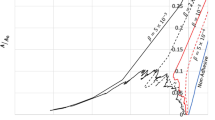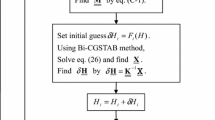Abstract
This paper deals with adhesive frictionless normal contact between one elastic flat solid and one stiff solid with rough surface. After computation of the equilibrium solution of the energy minimization principle and respecting the contact constraints, we aim at studying the stability of this equilibrium solution. This study of stability implies solving an eigenvalue problem with inequality constraints. To achieve this goal, we propose a proximal algorithm which enables qualifying the solution as stable or unstable and that gives the instability modes. This method has a low computational cost since no linear system inversion is required and is also suitable for parallel implementation. Illustrations are given for the Hertzian contact and for rough contact.













Similar content being viewed by others
References
Carbone G, Mangialardi L (2004) Adhesion and friction of an elastic half-space in contact with a slightly wavy rigid surface. J Mech Phys Solids 52(6):1267–1287
Carbone G, Mangialardi L (2008) Analysis of the adhesive contact of confined layers by using a Green’s function approach. J Mech Phys Solids 56(2):684–706
Carbone G, Scaraggi M, Tartaglino U (2009) Adhesive contact of rough surfaces: comparison between numerical calculations and analytical theories. Eur Phys J E 30:65–74
Carpick RW, Ogletree DF, Salmeron M (1978) A general equation for fitting contact area and friction versus load measurements. J Colloid Interface Sci 211:395–400
Chateau X, Nguyen Q (1991) Buckling of elastic structures in unilateral contact. Eur J Mech A Solids 10(1):71–89
Combettes PL, Pesquet JC (2011) Proximal splitting methods in signal processing. In: Fixed-point algorithms for inverse problems in science and engineering. Springer, pp 185–212
Condat L (2013) A primal–dual splitting method for convex optimization involving Lipschitzian, proximable and linear composite terms. J Optim Theory Appl 158(2):460–479
da Costa AP, Martins J, Figueiredo I, Júdice J (2004) The directional instability problem in systems with frictional contacts. Comput Methods Appl Mech Eng 193(3):357–384
Da Costa AP, Figueiredo I, Júdice J, Martins J (2001) A complementarity eigenproblem in the stability analysis of finite dimensional elastic systems with frictional contact. In: Complementarity: applications, algorithms and extensions. Springer, pp 67–83
Da Costa AP, Seeger A (2009) Numerical resolution of cone-constrained eigenvalue problems. Comput Appl Math 28(1):37–61
Da Costa AP, Seeger A (2010) Cone-constrained eigenvalue problems: theory and algorithms. Comput Optim Appl 45(1):25–57
Derjaguin B, Muller V, Toporov Y (1975) Effect of contact deformations on the adhesion of particles. J Colloid Interface Sci 53(2):314–326
Dong C, Bonnet M (2002) An integral formulation for steady-state elastoplastic contact over a coated half-plane. Comput Mech 28(2):105–121
Glowinski R (2015) Variational methods for the numerical solution of nonlinear elliptic problems. SIAM, Philadelphia
Hu YZ, Tonder K (1992) Simulation of 3-D random rough surface by 2-D digital filter and Fourier analysis. Int J Mach Tools Manuf 32:83–90
Jacq C, Nelias D, Lormand G, Girodin D (2002) Development of a three-dimensional semi-analytical elastic–plastic contact code. J Tribol 124(4):653–667
Jin F, Guo X (2013) Mechanics of axisymmetric adhesive contact of rough surfaces involving power-law graded materials. Int J Solids Struct 50(20):3375–3386
Johnson K (1995) The adhesion of two elastic bodies with slightly wavy surfaces. Int J Solids Struct 32(3–4):423–430
Johnson KL (1994) Contact mechanics. Cambridge University Press, Cambridge
Júdice JJ, Sherali HD, Ribeiro IM (2007) The eigenvalue complementarity problem. Comput Optim Appl 37(2):139–156
Johnson KL, Kendall K, Roberts AD (1971) Surface energy and the contact of elastic solids. Proc R Soc Lond A 324(1558):301–313
Kesari H, Lew AJ (2011) Effective macroscopic adhesive contact behavior induced by small surface roughness. J Mech Phys Solids 59(12):2488–2510
Longuet-Higgins MS (1957) Statistical properties of an isotropic random surface. Philos Trans R Soc A 250(975):157–174
Maugis D (1992) Adhesion of spheres: the JKR-DMT transition using a Dugdale model. J Colloid Interface Sci 150(1):243–269
Maugis D, Barquins M (1983) Adhesive contact of sectionally smooth-ended punches on elastic half-spaces: theory and experiment. J Phys D Appl Phys 16(10):1843
Meakin P (1998) Fractals, scaling and growth far from equilibrium. Cambridge University Press, Cambridge
Müser MH (2014) Single-asperity contact mechanics with positive and negative work of adhesion: influence of finite-range interactions and a continuum description for the squeeze-out of wetting fluids. Beilstein J Nanotechnol 5:419–437
Müser MH, Dapp WB (2015) The contact mechanics challenge: problem definition. arXiv preprint arXiv:1512.02403
Nguyen QS (2000) Stability and nonlinear solid mechanics. Wiley, Hoboken
Papangelo A, Ciavarella M (2017) A Maugis Dugdale cohesive solution for adhesion of a surface with a dimple. J R Soc Interface 14(127):2016.0996
Parikh N, Boyd S et al (2014) Proximal algorithms. Foundations and Trends\({\textregistered }\). Optimization 1(3):127–239
Pastewka L, Robbins MO (2014) Contact between rough surfaces and a criterion for macroscopic adhesion. Proc Natl Acad Sci 111(9):3298–3303
Prokopovich P, Perni S (2010) Multiasperity contact adhesion model for universal asperity height and radius of curvature distributions. Langmuir 26(22):17028–17036
Putignano C, Afferrante L, Carbone G, Demelio G (2012) A new efficient numerical method for contact mechanics of rough surfaces. Int J Solids Struct 42:338–343
Queiroz M, Judice J, Humes C Jr (2004) The symmetric eigenvalue complementarity problem. Math Comput 73(248):1849–1863
Rey V, Anciaux G, Molinari JF (2017) Normal adhesive contact on rough surfaces: efficient algorithm for FFT-based BEM resolution. Comput Mech (accepted manuscript, 2017)
Seeger A (1999) Eigenvalue analysis of equilibrium processes defined by linear complementarity conditions. Linear Algebra Appl 292(1–3):1–14
Stanley HM, Kato T (1997) An FFT-based method for rough surface contact. J Tribol 119:481–485
Westergaard H (1937) Bearing pressures and cracks. J Appl Mech 6:49–53
Zhang W, Jin F, Zhang S, Guo X (2014) Adhesive contact on randomly rough surfaces based on the double-Hertz model. J Appl Mech 81(5):051,008
Acknowledgements
Support for V.R. from the EPFL Fellows fellowship program co-funded by Marie Skłodowska-Curie, Horizon 2020 Grant Agreement No. 665667 is gratefully acknowledged. The authors would like to thank Professor Jean-François Molinari and Guillaume Anciaux for helpful discussions.
Author information
Authors and Affiliations
Corresponding author
Rights and permissions
About this article
Cite this article
Rey, V., Bleyer, J. Stability analysis of rough surfaces in adhesive normal contact. Comput Mech 62, 1155–1167 (2018). https://doi.org/10.1007/s00466-018-1556-y
Received:
Accepted:
Published:
Issue Date:
DOI: https://doi.org/10.1007/s00466-018-1556-y




